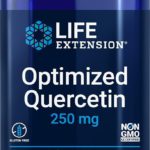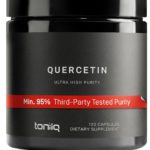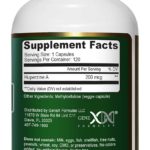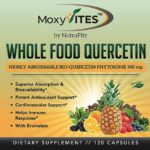Are you looking for a natural way to combat the flu? Look no further than quercetin! Quercetin is a powerful antioxidant found in various fruits, vegetables, and herbs that has been shown to possess anti-viral properties. In this article, we will explore the numerous benefits of quercetin for fighting the flu, including its ability to boost the immune system, reduce symptoms, and potentially prevent viral replication. Discover how this incredible compound can help you stay healthy and ward off those pesky flu bugs. Let’s delve into the world of quercetin and its remarkable flu-fighting abilities!

I. Introduction to Quercetin and the Flu
A. Overview of Quercetin
Quercetin is a natural compound found in various fruits and vegetables. It belongs to a group of plant compounds known as flavonoids, which are known for their antioxidant and anti-inflammatory properties. Quercetin has gained attention for its potential health benefits, including its antiviral properties and immune-supporting effects.
B. Understanding the Flu
The flu, also known as influenza, is a contagious respiratory illness caused by influenza viruses. It can range from mild to severe and can result in serious complications, especially among high-risk individuals such as the elderly, individuals with chronic health conditions, and young children. The flu is typically characterized by symptoms such as fever, cough, sore throat, muscle aches, fatigue, and respiratory congestion.
II. Quercetin’s Antiviral Properties
A. Mechanism of Action
Quercetin has been found to exhibit antiviral activity by interfering with the replication of viruses. It inhibits the enzymes necessary for viral replication and helps prevent the virus from spreading throughout the body.
B. Inhibition of Virus Entry and Replication
Quercetin has the ability to inhibit the entry of viruses into host cells, thereby preventing infection. It disrupts the interaction between the virus and host cell receptors, making it more difficult for the virus to invade and replicate.
C. Reduction of Viral Load
By inhibiting viral replication and entry, quercetin can help reduce the overall viral load in the body. This can potentially lead to faster recovery and a milder course of illness.
III. Quercetin’s Role in Immune Support
A. Enhancement of Immune Function
Quercetin has been shown to modulate and enhance immune function. It stimulates the production and activity of immune cells, such as natural killer cells and T cells, which play a crucial role in defending against viral infections.
B. Modulation of Inflammatory Response
During viral infections, the body’s immune system can trigger an inflammatory response to fight off the virus. However, excess inflammation can lead to tissue damage. Quercetin helps regulate the body’s inflammatory response, preventing excessive inflammation and maintaining a balanced immune system.
C. Increase in Antioxidant Capacity
Quercetin acts as a potent antioxidant, scavenging free radicals and reducing oxidative stress in the body. By reducing oxidative damage, quercetin helps support overall immune health and can potentially mitigate the severity of flu symptoms.
IV. Quercetin’s Effects on Flu Symptoms
A. Alleviation of Respiratory Symptoms
Quercetin has been found to have bronchodilatory effects, meaning it helps relax and open up the airways. This can provide relief from respiratory symptoms associated with the flu, such as coughing, wheezing, and congestion.
B. Reduction of Fever
Elevated body temperature, or fever, is a common symptom of the flu. Quercetin has been shown to possess antipyretic properties, meaning it can help reduce fever and promote comfort during illness.
C. Relief from Muscle Aches and Fatigue
Muscle aches and fatigue are often experienced during the flu. Quercetin’s anti-inflammatory properties can help alleviate muscle soreness, while its ability to enhance immune function may contribute to a faster recovery and reduction in fatigue.

V. Quercetin’s Benefits for At-Risk Populations
A. Protection for the Elderly
The elderly population is particularly vulnerable to the complications of the flu. Quercetin’s antiviral properties and immune-supporting effects make it a valuable supplement for the elderly, helping to reduce the severity and duration of flu symptoms.
B. Support for Individuals with Chronic Conditions
Individuals with chronic health conditions, such as diabetes, heart disease, and respiratory disorders, may experience more severe flu symptoms and have a higher risk of complications. Quercetin’s immune-supporting properties can help strengthen their immune system and potentially lower the risk of complications.
C. Prevention and Treatment for Children
Children, especially those attending school or daycare, are often exposed to various viruses, including the flu. Quercetin, when used in appropriate dosages, can help strengthen their immune system and provide an additional layer of protection against the flu.
VI. Quercetin’s Synergistic Effects with Other Compounds
A. Vitamin C
Quercetin and vitamin C have been found to have synergistic effects when used together. Vitamin C helps enhance quercetin’s antioxidant properties and improves its absorption in the body. This combination can provide a stronger immune-boosting effect.
B. Zinc
Zinc is an essential mineral known for its immune-modulating properties. Combining quercetin with zinc can enhance its antiviral properties and help support immune function against the flu.
C. Echinacea
Echinacea is an herb traditionally used to support immune health. Studies have shown that combining quercetin with echinacea can enhance its antiviral effects and provide additional support during flu season.

VII. Quercetin’s Safety and Side Effects
A. Overview of Safety Profile
Quercetin is generally considered safe for most individuals when used as directed. It is a naturally occurring compound found in foods and is commonly consumed as part of a balanced diet. However, it is always advisable to consult with a healthcare professional before starting any new supplement regimen.
B. Potential Side Effects
While quercetin is well-tolerated by most individuals, some people may experience mild gastrointestinal side effects, such as nausea or stomach discomfort. These side effects are generally rare and can often be minimized by taking quercetin with food.
C. Drug Interactions to Consider
Quercetin may have interactions with certain medications, such as blood thinners or antibiotics. It is important to discuss any potential drug interactions with a healthcare professional before adding quercetin to your routine.
VIII. Sources of Quercetin
A. Natural Sources
Quercetin is naturally present in various fruits and vegetables, including apples, onions, berries, citrus fruits, and leafy green vegetables. Incorporating these foods into your diet can help increase your quercetin intake.
B. Dietary Supplements
Quercetin is also available in supplement form, typically as quercetin dihydrate or quercetin extracted from natural sources. Supplements can provide a reliable and convenient way to ensure an adequate intake of quercetin, especially during flu season or when dietary sources may be limited.
IX. How to Use Quercetin for Flu Prevention and Treatment
A. Recommended Dosage
The recommended dosage of quercetin for flu prevention and treatment may vary depending on individual factors, such as age, overall health, and other medications being taken. It is best to follow the dosage instructions provided by the specific supplement manufacturer or consult with a healthcare professional for personalized recommendations.
B. Incorporating Quercetin into Your Diet
To increase your dietary intake of quercetin, consider incorporating quercetin-rich foods into your meals and snacks. This can include adding berries to your breakfast, including onions in savory dishes, enjoying a fresh apple as a snack, or incorporating leafy greens into salads or smoothies.
X. Quercetin and Vaccine Efficacy
A. Enhancing Vaccine Response
Quercetin’s immune-boosting properties may potentially enhance the efficacy of vaccines. By supporting immune function and reducing inflammation, quercetin can help promote a stronger immune response to the vaccine, leading to improved protection against the flu.
B. Complementary Approach to Vaccination
While quercetin can be used as a complementary approach to flu vaccination, it is important to note that it should not replace the flu vaccine itself. The flu vaccine remains the most effective way to prevent the flu and its complications. Quercetin can be used in conjunction with vaccination to provide additional support to the immune system.
In conclusion, quercetin offers a range of potential benefits for fighting the flu. Its antiviral properties, immune-supporting effects, and ability to alleviate flu symptoms make it a valuable natural compound for both prevention and treatment. Whether consumed through dietary sources or supplements, quercetin can be a valuable addition to support overall immune health during flu season. It is important to consult with a healthcare professional before starting any new supplement regimen, especially for individuals with underlying health conditions or those taking medications with potential interactions. With its potential synergistic effects with other compounds and its compatibility with flu vaccination, quercetin provides a comprehensive approach to flu prevention and treatment.






